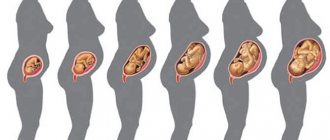07.01.2018
Understanding what is normal bowel movement frequency for a newborn baby is an important part of breastfeeding success.
Until recently, little was known about stool frequency and consistency in exclusively breastfed infants. By the mid-20th century, most infants were fed homemade cow's milk formulas with early introduction of complementary foods. Such a diet is characterized by infrequent stools, which have come to be perceived as the norm. In contrast, frequent and loose/loose stools, typical of breastfed babies, were sometimes mistaken for diarrhea and treated accordingly, even with drastic measures such as complete weaning.
Older breastfed children with rare stools normal for infants were treated for constipation in vain.
What is considered normal?
After the baby is born, during the first two to three days, his stool consists of meconium. This is a dark olive mass that has accumulated in the baby’s intestines over the long nine months of intrauterine development. There are desquamated cells of the intestinal mucosa and swallowed amniotic fluid. Meconium has a tar-like consistency and is practically odorless. Normally, it begins to be released from the intestines to the outside after the baby is born.
After the entire accumulated volume of meconium leaves the intestines, the baby may not have stool until the mother has a lot of milk, since the colostrum that the baby eats in the first days is absorbed almost completely. Sometimes there is stool, but in small quantities and is green in color. This is the norm; such a chair is called transitional.
After the mother has established active lactation, the baby has “mature” stools, which will remain until complementary feeding or supplementary feeding is introduced. It is a homogeneous yellow pulp with the consistency of thin sour cream with the smell of sour milk. Such stool indicates good digestion of mother's milk. As for the normal frequency of stool, most newborns have a bowel movement almost after every feeding, that is, the number of bowel movements per day can reach 5-8, and sometimes even 10.
However, there is a rare variant of the norm when breast milk is so completely digested that practically nothing remains in the intestines, and bowel movements can occur once every few days, sometimes even once a week. But such a condition can be considered normal only against the background of full breastfeeding and provided that the baby is in good health (normal behavior, absence of abdominal pain and significant straining during bowel movements). As a rule, this feature develops in some infants no earlier than 3 months of life.
With artificial feeding, the stool may be the same as with natural feeding, or have a thicker consistency and a darker, brownish color. Defecation must occur at least once a day; anything else is considered constipation.
The above is an ideal, but, unfortunately, there are certain deviations from this “correct” state. What can they tell you?
Misconceptions about infant stool
For decades, La Leche League and other breastfeeding advocates have been disseminating information about the stool patterns of healthy breastfed babies to reassure mothers and protect babies from unnecessary “medication.” Unfortunately, many modern mothers today do not know what a normal baby’s stool looks like. Some children are still mistakenly treated for constipation. And one of the most troubling consequences of the lack of information about infant stool is that many still do not notice the connection between certain bowel movements and possible weight loss.
In the past, in the literature for mothers, the stool norm for infants was described as follows: frequent and loose stools, and a variation of the norm was also mentioned – more rare bowel movements, up to once every few days. It turned out that both frequent and infrequent stools fell within the definition of normal, and the criteria for sufficient milk consumption were based solely on the number of urinations.
In the 1980s, the norm was revised: the concept of a norm for infants of a certain age group appeared. Multiple daily bowel movements have become the norm for infants during the first 6-8 weeks of life.
Why can’t the number of urinations alone serve as a guide for assessing the effectiveness of a baby’s sucking? It has long been known that the composition and quantity of human milk changes both within several weeks after birth and during one feeding. The first milk, colostrum, is extremely beneficial for the baby's health, and also gives a natural laxative effect and promotes the rapid passage of meconium. Although the mother's milk volume increases significantly within a few days after birth, when the milk "comes in", the transition from colostrum to mature milk takes several weeks. The composition of transitional and mature milk also affects the frequency of stools typical for newborn infants. … “The frequency of bowel movements of newborns after the third day of life is at least five times a day, as a result of the presence of additional fats in transitional and mature milk, which increase the volume of the baby’s stool.”
"Wrong" color
It happens that a “mature” stool does not set for a long time; for a long time it has a transitional character - with greenery, sometimes with an admixture of mucus. There may be several reasons:
- malnutrition due to lack of milk from the mother, insufficient sucking, tight breasts, inverted and flat nipples or other reasons (the so-called “hungry stool”);
- the predominance of fruits and vegetables in the mother’s diet compared to other products;
- inflammation of the intestinal mucosa.
The latter condition is often observed after hypoxia suffered during childbirth or pregnancy, since the intestinal mucosa suffers from a lack of oxygen and is difficult to recover subsequently. Inflammation can also be caused by the influence of synthetic substances - flavorings, preservatives, dyes present in the mother's diet. Another cause of inflammation of the mucous membrane is a disruption of the normal intestinal microflora. In this case, inflammation is caused by the aggressive effect of pathogenic microbes on the mucosa.
Of course, taking antibiotics by a baby or mother significantly increases the risk of developing intestinal dysbiosis (disturbance of normal microflora). It also happens that in mother’s milk there is a growth of pathogenic microorganisms that disrupt the growth of normal microflora in the baby’s intestines.
How to help your baby?
What to do in cases where a child cannot have normal stool for a long time? First of all, you should focus on the well-being of the baby itself. Even healthy babies who are exclusively breastfed can have a protracted period of bowel movement. The fact is that the human body is a complex system where everything happens according to its own rules and at an individual speed. Colonizing the intestines with microbes friendly to the human body is a slow and difficult task. Therefore, it is considered quite acceptable if, during the first month of life, an infant has transitional stool, provided that he feels well and has sufficiently gained in height and weight. What does it mean? According to WHO recommendations, the minimum acceptable weight gain is 500 g per month or, respectively, 250 g in 2 weeks. Estimation of weight gain over a shorter period of time is considered incorrect.
And even if this trend (green in the stool) subsequently continues, this condition does not always require active treatment. If the baby is healthy and cheerful, does not suffer from abdominal pain, and is gaining height and weight normally, it would be better to leave everything as it is. They have not yet come up with a better means than breast milk to create conditions for the proper colonization of the intestinal mucosa with beneficial microorganisms - in the event that there are no pathogenic microorganisms in the milk.
A medicinal solution to this problem should be taken only if the baby’s well-being suffers; for example, he suffers from severe intestinal colic, he has allergic skin reactions, in particular rashes, itching, or he does not gain enough weight and grow.
Diet. The sequence of actions in such a situation should be as follows: if necessary, first determine weight gain over the last two weeks, then carefully check and establish the maternal diet. Excluded: excess vegetables and fruits; products containing artificial additives (yogurt with fruit fillings, sausages and sausages, any canned food, industrial juices, confectionery, as well as synthetic vitamin preparations, including special complexes for nursing). Only after this are examinations carried out - scatological examination (microscopic and chemical examination of feces) and analysis of feces for flora .
Surveys. The first analysis of a newborn’s stool will show how the digestion processes are progressing, and will also allow one to exclude or confirm the presence of an inflammatory process in the intestines (this may be indicated by an increased number of leukocytes, a sharply acidic reaction in the stool, or detection of hidden blood in it). When analyzing stool for flora, one should focus primarily on the presence of pathogenic microbes, which normally should not be present in the intestines at all, or their number should not exceed certain limits.
The number of normal microorganisms - bifidobacteria and lactobacilli - can reflect the real picture of intestinal flora only if fresh feces were analyzed - no later than 2 hours after defecation. This causes certain difficulties for parents, because after the child has defecated, they will have to rush to the appropriate laboratory. If feces are submitted at a later date, the number of normal microorganisms is not indicative , and you should only pay attention to the number of pathogenic microbes.
If the growth of pathogenic staphylococcus (aureus or hemolytic) is detected in the stool, the mother's milk is inoculated, since these microbes can live in the milk ducts and enter the milk.
Treatment. When the growth of pathogenic microbes in milk is detected, their sensitivity to certain antibiotics is necessarily determined, i.e. what antibacterial drugs will be most effective in eliminating these microbes, and the mother is treated accordingly (sometimes breastfeeding should be stopped for this period). As a rule, after the mother recovers, the baby’s problems also go away, which can be confirmed by repeating a stool flora test . Repeated studies should be carried out two to three weeks after the end of the course of antibiotic therapy in the mother.
To treat serious intestinal dysbiosis - a disturbance of the normal microflora - phages are usually used (preparations of special viruses that destroy a certain type of pathogenic microorganisms and do not affect the flora as a whole) and drugs to restore normal microflora.
Features and character of infant stool
It never hurts to discuss your baby's stool with every mother. If a fully breastfed baby's stool is grainy, yellow, mustard, or tan-colored, and the baby has bowel movements every day, it can be emphasized that the baby is breastfeeding well and effectively. Such visual evidence can greatly encourage and reassure a mother who is wondering if she has enough milk.
While it can sometimes be difficult for parents to figure out if a baby has peed in a diaper and how many times, a dirty diaper is a no-brainer. If a mother is worried that her baby has diarrhea, an extra reminder about normal bowel movements in newborns will only make her happy, reassure her and give her confidence that she has enough milk and the baby is healthy and suckling well.
And vice versa - a rare stool may not attract the attention of relatives or doctors. Bowel frequency norms for older children may be erroneously applied to a newborn. Rare bowel movements may be mistaken for constipation. As a rule, in such cases, children have already experienced poor weight gain or weight loss was noticed later.
If your baby rarely has bowel movements, it is important to monitor your baby's frequency of urination. The urine of an infant who has sucked enough milk is pale yellow and transparent. The volume of urine is determined by the number and weight of wet diapers. But even if the amount of urination is normal, the lack of daily bowel movements is a cause for concern.
Presence of “white lumps”
Sometimes there is an admixture of white lumps in the child’s stool, as if homemade cottage cheese had been mixed into it. If the baby is gaining weight normally, this condition means some overeating. This usually happens if the baby is offered the breast frequently to calm him down, regardless of the reason for the anxiety or when the baby last fed. There is nothing wrong with this, it’s just that a certain amount of milk proteins and fats in this case is underdigested and forms a similar “sediment” in the stool.
If such a feature of feces is accompanied by poor weight gain, most likely it is due to insufficient quantities or reduced activity of enzymes secreted by the digestive glands. If the weight loss is significant and does not tend to decrease, therapy with enzyme preparations is carried out.
Lactase deficiency
In some cases, stool has a thinner than usual, watery consistency and has a more sour odor. If your baby happens to have a bowel movement on a cotton diaper, you may notice a watery area around the fecal spot. Often in this condition, feces may be released in small portions even when gas is released. The color of stool is usually yellow or mustard. Similar symptoms can occur due to insufficient digestion of carbohydrates. Undigested carbohydrates, remaining unchanged in the intestine, “attract” a large amount of water into the lumen, so the feces become more liquid. A more acidic reaction of feces due to insufficient hygiene of the child can cause the development of diaper rash .
The most common type of indigestion is lactose, the milk sugar. This is due to a discrepancy between the amount of lactose supplied with milk and the lactase enzyme required for its digestion, and is called lactase deficiency. This does not always mean insufficient production of the corresponding enzyme in the baby’s gastrointestinal tract. Perhaps the mother has a genetically determined high amount of lactose or it is increased due to the overload of her diet with dairy products, especially fresh milk. In some cases, severe lactase deficiency goes hand in hand with intestinal dysbiosis: a more acidic reaction of intestinal contents can interfere with the growth of normal intestinal flora, and an insufficient number of friendly microorganisms, in turn, makes it difficult to digest carbohydrates.
To confirm the diagnosis, a stool test for carbohydrates is necessary. To decide on the correct tactics in this case, it is necessary to take into account, again, the well-being of the baby. There is no need to worry if, despite the “wrong” appearance of stool, your little man does not suffer from colic and is gaining weight normally. Intervention in the situation is necessary if lactase deficiency is the cause of significant weight loss or severe colic. First of all, the mother’s diet should be adjusted: the first step should be to exclude fresh milk from the diet; if this is not effective enough, a significant reduction in the amount of fermented milk products (with the exception of cheese, which has practically no milk sugar). If these measures are not enough, treatment is carried out using the lactase enzyme.
Constipation during breastfeeding
When can you tell that your baby is constipated? In addition to the absence of stool for more than a day (except for specified cases of complete digestion of milk), constipation can include conditions that do not allow the baby to empty his bowels on his own or that significantly complicate bowel movements.
As a rule, during breastfeeding, the only cause of constipation is spasm of the anal sphincter and, less often, the mother’s incorrect diet. Since in this case not only bowel movements are difficult, but also the passage of gases, such babies suffer from severe colic. Moreover, the stool may be liquid, but rare.
The main causes of this condition are lactase deficiency and birth injuries, followed by problems with the nervous system, causing changes in the tone of not only skeletal muscles, but also sphincter muscles. In this case, stool can be provoked by inserting a gas tube, that is, by gently stimulating the anus. (We take a tube of the smallest diameter, lubricate the tip with Vaseline and insert it into the anus to a depth of 1.5-2 cm. The position of the child is on the back or on the side.) Treatment prescribed by a neurologist for changes in muscle tone and other neurological diseases is often can improve or even normalize the situation over time. Attempts to use laxatives often do not give the desired effect.
If you are breastfeeding your baby and are experiencing difficulties with bowel movements, first of all pay attention to your own diet. With the help of certain products (prunes, dried apricots, peaches, boiled beets, fresh kefir) you can try to influence the baby’s stool. If this is not enough, you can offer the baby a decoction and puree of prunes, but it is better to wait until at least 4 months of age, since it is not advisable to introduce fruit and vegetable complementary foods and juices to children until 6 months (at least 4). .
Two types of milk
The terms "foremilk" and "hind milk" describe the difference between the composition of human milk during a single feeding. The milk at the beginning of feeding is called foremilk. Foremilk is plentiful and has a relatively low percentage of calories and fat. As suckling progresses, the amount of fat in the milk increases. The high-calorie milk that the baby sucks at the end of feeding is called hind milk. It is important for your baby to get enough of both foremilk and hindmilk for growth and development.
Based on these data, the question “Does the baby have enough milk?” can be answered with the question “Front or rear?” In the first weeks, counting wet diapers can only answer the first part of the question. Wet diapers indicate that the baby is sucking some foremilk. The baby simply will not be able to have bowel movements several times a day if he does not first suck out enough foremilk to maintain the body's water balance.
However, the opposite is possible. Feeding patterns, ineffective sucking, or other feeding problems can cause the mother's milk supply to decrease or prevent the baby from getting enough hindmilk. In this situation, it is quite possible that the baby is not dehydrated because he is sucking enough foremilk, but at the same time the baby is not getting enough calories because he is not sucking enough hindmilk. Thus, frequent urination is a reliable sign of drinking enough fluid from the sucking of foremilk. Repeated bowel movements are a sign of getting enough calories from hind milk. To fully evaluate breastfeeding in the neonatal period, it is important to consider both conditions.
Lack of bowel movements during the newborn period may be due to insufficient caloric intake and may also be a symptom of poor weight gain. Early detection of this sign can be critical to both the overall well-being of the baby and continued feeding. In advanced cases, a lack of calories can lead to weakened sucking, reduced milk production and severe dehydration. Despite the fact that simple causes of calorie deficiency can be eliminated at any stage of feeding, it is easiest to establish lactation, take care of sufficient milk production and normal weight gain immediately after childbirth. The longer you delay solving a problem, the more time and effort it will take to resolve it.
Constipation during artificial feeding
With artificial feeding, constipation occurs, unfortunately, much more often, since the digestion of infant formula is difficult for the immature digestive system of newborns and infants. First of all, it is advisable to replace approximately half of the daily food with fermented milk mixture (this is possible after 3 weeks of age, when the child’s body is able to digest fermented milk mixtures), most often this is enough.
In all other cases of constipation, both with artificial and natural feeding, you can use (of course, only after consultation with the doctor who is observing the baby!) SUPPORTS WITH GLYCERIN (the dose in the first half of life is 1/4-1/2 candles) , microenemas MICROLAX, DUPHALAC. As a rule, the situation is resolved after introducing vegetable complementary foods into the baby’s diet, but it is better not to introduce complementary foods before 6 months.
Stool and complementary feeding
As the child grows up, the appearance of greens in the stool may occur when new foods are introduced into the baby's diet. How should we feel about this?
First of all, it should be remembered that one of the common causes of disruption of the intestinal biocenosis is the unreasonably early prescription of complementary foods or vitamin supplements. With pure breastfeeding, it is unreasonably early to offer any food other than breast milk before 6 months of life. When artificial feeding, these dates can be shifted to an earlier appointment, but no more than 1-1.5 months. In addition, nutritionists are increasingly opposed to the appointment of fruit juices as the first additional course (in contrast to earlier views, according to which the appointment of juices was considered correct almost from the second month of life!). Juices are rich in fruit acids, which can have an unnecessarily aggressive effect on the intestinal mucosa, even causing inflammation.
If, after prescribing a new dish, especially a green vegetable, you observe the appearance of a green color in your stool without other symptoms (bloating and abdominal pain, skin rash, changes in behavior), you don’t have to worry. If the appearance of greenery in the stool accompanies the above symptoms, further consumption of the dish should be stopped. Such a reaction to a new dish may mean the development of an allergic reaction or difficulty in digesting and assimilating it.
Baby at 9 months
In the first year, parents are surprised to see how quickly the child grows. Does a child develop normally at 9 months and how does he change at this time?
Baby's weight and height at 9 months
The average weight of girls by the end of the 9th month of life is 8.5-9.5? kg. Boys, as a rule, are a little heavier, their average weight reaches 9-10? kg. The growth rate of babies during this period remains quite high compared to older children. So, the monthly weight gain of a baby is 500 g. In total, in the first 9 months the child gains an average of 6? kg!
height at 9 months increases by 1.5 cm. The rate of increase in body length is approximately the same in children of both sexes. From the moment of birth until the end of the ninth month of life, the child grows by approximately 20 cm.
Baby's sleep at 9 months
A 9-month-old baby 's at night remains quite long, up to 9.5-10 hours. Most babies can sleep without interruption, but some babies may wake up to drink, suck on their mother's breast, or for some other reason - for example, because the baby has opened up and feels cool. Prolonged wakefulness in the middle of the night in healthy children of this age, as a rule, no longer occurs. The baby can easily be “lulled to sleep” until the morning.
During the daytime, children need rest. The total duration of a double nap is on average 2.5-3 hours, but its duration can vary not only among different children, but even within one child.
Caution - danger!
The child's mobility increases the likelihood of traumatic situations. It should be remembered that a curious baby will definitely be interested in those cabinet doors or drawers that are within his reach. You need to check in advance whether there are any sharp, fragile or too small objects that could be potentially dangerous for the child. Perhaps the best way out of the situation is to secure the doors and drawers so that the baby cannot open them. Sockets must be closed with special plugs. Sharp corners of furniture and heavy objects that a child can pull off the table by grabbing a wire or tablecloth can also cause injuries. An adult sometimes needs to imagine himself in the child’s place and try to predict where the baby will go and what might interest him. Perhaps this will make the baby's environment less dangerous.
The playpen is only a temporary solution to the problem. It is convenient to use if you need to leave your child unattended for a short time.
What can a 9 month old baby do?
Without any exaggeration, a child of 9 months The baby spends all the time free from sleeping and eating in motion. Crawling, sitting, trying to stand up, or standing up with support or support - these are the maneuvers that the baby can repeat endlessly throughout the day.
Some children are very persistent in their desire to walk. It is difficult to limit them, but you should not specifically push the child to get up and walk earlier. There is a time for everything: the baby’s body must gradually mature for more complex motor functions.
Some children change the usual course of events, first acquiring the skills of standing and only then consolidating their success in sitting.
The baby’s active speech develops, and he begins to briefly comment on his own actions. A child, for example, can accompany his communication with an adult with a short “na” or “yes”, giving or demanding some thing or toy. Intonation appears when pronouncing sounds. Kids master the pronunciation of the simplest two-syllable words - “mom”, “dad”, “baba”. Thus, “babbling” speech becomes more and more meaningful.
At the 9th month, it is important to continue (or, without delay, start, if this has not been done before) developmental activities with the baby. It should be remembered that children in the second half of life are developing rapidly, and they need to be given the opportunity to optimally use their natural potential. The most interesting thing is that the efforts of an adult can be minimal and they come down to one thing, the most important thing - to pay more attention to the baby.
Simple games that arouse obvious interest in the baby: “hide and seek”, “hide and seek”, “magpie-crow” - sorting and looking at bright toys, soft books with large, understandable drawings; explaining something happening on the street using simple words, for example “birds”, “cat”, “dog”, “car” - this is an arsenal that can well be used by adults for the better development of a child.
9 months: walks with baby
During the warm season, mother and baby can spend most of the day outside. The baby sleeps only part of this time, the rest of the time he watches with interest what is happening around him. Thus, a walk can be regarded not so much as a child sleeping in the open air, but as a way to ensure his better development, an additional opportunity to satisfy the baby’s curiosity.
Baby's stool at 9 months
Daily single stool is the norm, although options are possible - intermittent delays for a day or its increase up to 2-3 times a day - depending on the child’s diet.
The baby urinates on average 10 times a day, the urination regime varies depending on the drinking regime and the ambient temperature: in hot weather the frequency of urination becomes less.
9 months: pediatrician
A pediatrician examines a healthy child at 9 months . In addition, at this age, the baby should be routinely examined by a surgeon and a pediatric dentist. Consultations with other specialists are prescribed only when indicated.
Baby's nutrition at 9 months
The table of a 9 month old baby is quite varied. By this age, all three types of compulsory complementary foods should be introduced into the baby’s diet - vegetable puree, porridge, meat. In addition, the child should receive about 40 g of cottage cheese. Already familiar products for the baby should be juices and fruit purees. Twice a week, the baby is offered half an egg yolk, which is mixed with puree. You can offer your child a baby cookie or a piece of bread. Of course, he is not yet able to bite off, but solid food is a good “massager” for the gums during teething. At the same time, you need to make sure that too large pieces do not fall into the baby’s mouth, as there is a danger of blocking the respiratory tract.
At 9 months, the child still eats five times a day.
If the baby receives mother's milk, this age is not a reason to cancel it. Of course, breast milk cannot be the only food for a child of this age, but it can completely satisfy the need for dairy products. We should not forget about such a positive effect of breastfeeding as the transfer of passive immunity. The baby’s circle of “acquaintances” is expanding every day, and the possibility of infection, unfortunately, is also increasing. Special proteins in mother's milk - immunoglobulins - provide quite reliable protection against most known microbes and viruses.
Your baby may need to breastfeed at night. You shouldn't deny him this pleasure. It should be understood that, most likely, such a need is dictated not so much by hunger, but by an attempt to find protection in a familiar environment that is absolutely safe for the child - in the mother’s arms.
Children who are bottle-fed should receive adapted formulas. At 9 months, your child can eat kefir. Whole cow's milk is not recommended for babies in the first year of life.
Vaccinations at 9 months
scheduled vaccinations at the 9th month of life. An individual vaccination schedule is used if some of them were delayed or the baby, for some reason, generally began to be vaccinated later.
You may be interested in the article “Reflexes of a newborn” on the website mamaexpert.ru











